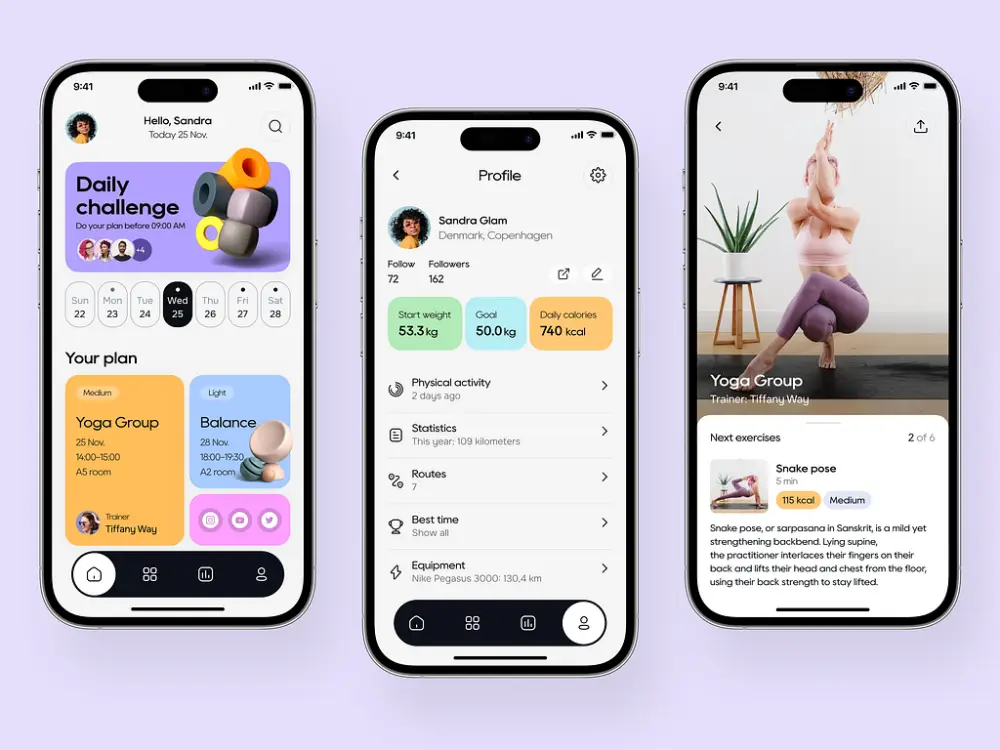In recent years, technological advancements have revolutionized the transport and logistics industry. Many businesses now leverage logistics apps to streamline their operations, making processes more efficient and cost-effective.
In this article, we will explore how logistics app development can enhance operational efficiency, cut costs, and improve customer satisfaction. Continue reading to discover how these innovative tools can transform your logistics operations!
I. Logistics Application Overview
A logistics application is software that helps organizations manage shipment activities such as routing, vehicle maintenance, fleet management, transportation, and tracking. These solutions also allow clients to book their shipments easily with a single click.
You can benefit from real-time shipment updates when selecting an application for your transportation and logistics needs. These apps greatly aid the retail industry by enabling efficient handling of daily operations, which leads to improved productivity.
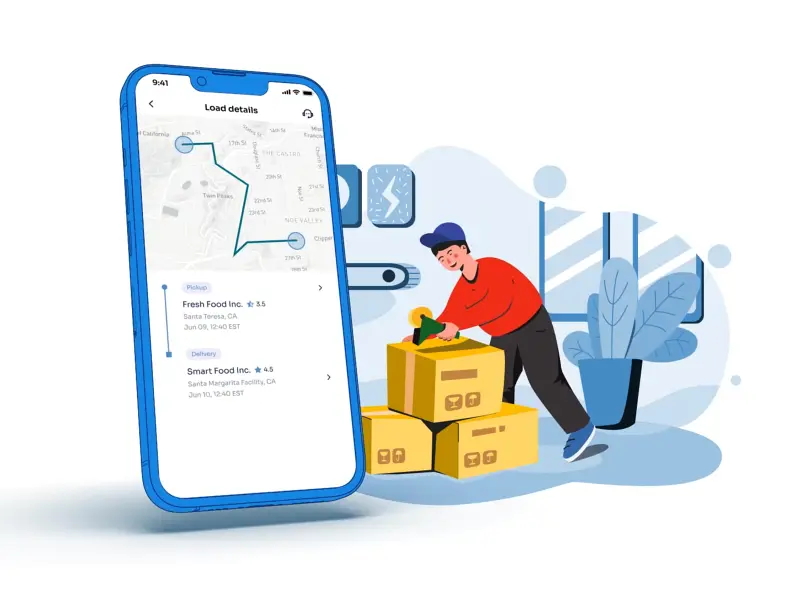
II. Most Popular Types of Logistics Apps
1. Fleet Management Applications
Without your fleet, you cannot transport assets from point A to point B, halting your business operations.
A fleet management solution helps you manage your vehicles efficiently. Regardless of fleet size, this application collects, manages, and stores all information about your trucks, including maintenance history. This data is crucial for timely maintenance or replacement. Some transportation management apps also track service costs to help you calculate total ownership expenses, send maintenance notifications, generate reports, and more. This ensures your vehicles run smoothly and cost-effectively.
2. On-Demand Logistics Applications
If your trucks are not always fully loaded, consider using an on-demand logistics app to create an extra income source. Here’s how these solutions work:
- A shipper creates a request.
- The nearest driver with available space gets the alert, agrees to the request, and collects the shipment.
- The shipper tracks the cargo’s location and receives updates on the shipment status.
- After the shipment is delivered, the system generates an invoice for the sender.
Still want to see more Logistic articles? Check here:
3. Warehouse and Inventory Management Applications
A warehouse management app ensures your shipments reach their destinations on time. These applications resemble real-time tracking systems specifically designed for warehouse owners, while real-time tracking tools serve a broader audience.
Warehouse management apps equipped with barcode scanning technologies help you track the status of numerous deliveries. The best apps integrate with internal databases to update information in real time, reducing manual input and minimizing human error.
4. Delivery Applications
Delivery apps help businesses transport goods from one location to another. They connect businesses with customers through a network of couriers. Clients can choose between on-demand delivery for immediate needs or scheduled delivery for a specific time and date.
These apps let customers track orders in real-time and provide multiple payment methods, including cash and credit card, and mobile banking. They enable businesses to provide fast and convenient delivery, enhancing customer service while giving clients control over the entire process.
5. Driver Management
Driver management solutions for mobile and web help maintain driver information and meet their requirements for better logistics operations. These apps allow you to manage driver profiles, monitor the goods they carry, and track their location.
III. Advantages of Developing Logistics Applications
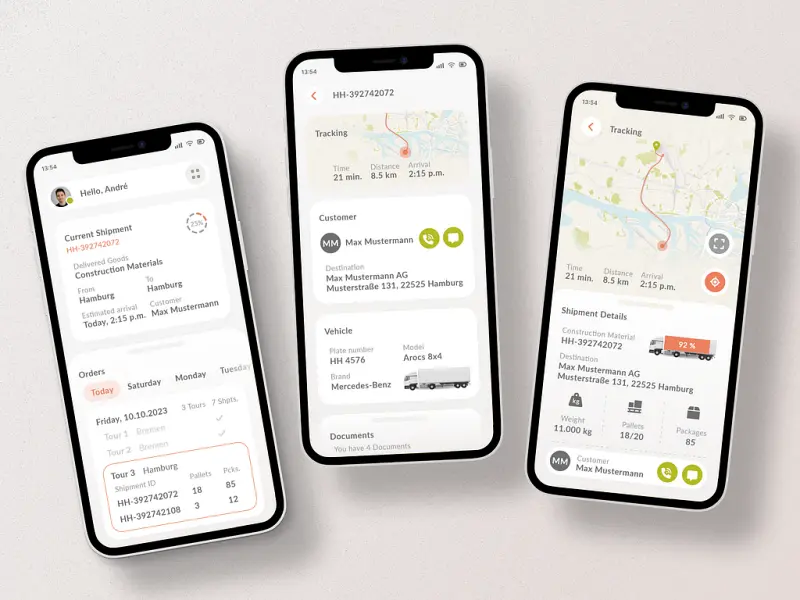
Here are some key benefits of logistics app development:
Enhances Company Reputation
A logistics app with an easy-to-use interface engages clients and creates a favorable perception of the business. It simplifies tasks, enhances the user experience, and boosts the company’s reputation. The app’s simple interface ensures that users will have a great user experience, ultimately creating a positive company image and ensuring customer satisfaction.
Reduces Paperwork
With digital logistics apps, access to information becomes instantaneous, eliminating the need to fill out and file paper forms and place orders verbally. Through e-bill payouts, you can make online payment confirmations with electronic delivery proof and track deliveries online. Hence, it offers easy availability and reduces time and losses in paper and money consumption.
Decrease Delivery Time and Cost
Real-time snapshots of truck delivery statuses and simplified reporting tools bring more clarity and control to business operations. By linking trustworthy data to usage models, businesses can reduce the number of trucks needed for freight deliveries, optimize route planning, and manage fuel expenses more effectively. Developing a logistics mobile app helps maintain high transparency and reduces costs.
Simplify the Supply Chain Process
A logistics app simplifies the complexities of supply chain processes, leading to greater efficiency. It ensures data integrity through blockchain technology, creating a secure and streamlined supply chain. The app provides a robust and reliable infrastructure, functioning like an intelligent system that helps businesses maintain fast and dependable service.
Manage Warehouse Accurately
Stock management is a crucial aspect of logistics with significant implications. It involves tracking commodities shipped from and stored in the warehouse. Essential tasks include ensuring that trucks are fully loaded, avoiding surplus inventory, and preventing stock exhaustion before delivery.
Using AI-driven logistics mobile applications can improve warehouse planning. These apps provide automatic stock status notifications, helping manage inventory more effectively.
Looking to Outsource Development?
Contact TECHVIFY – Vietnam’s Leading Offshore Software Development & Outsourcing Company, for consultation and development services.
IV. Key Features for Logistics App Development
Here are a few crucial features for logistics app development:
1. Truck Tracking
Deploying GPS positioning apps allows you to show the location of vehicles on a map. These app-based platforms track shipments, optimize the shipping of goods, and provide full details about shipments.
Applications receive GPS coordinates from sensors and store the data from the trucks’ GPS units, displaying this information on the map.
These apps achieve higher accuracy in GPS positioning by using technologies like C++, QML, JavaScript, the Qt framework, and Kalman filter algorithms.
2. Best Route
One of the most helpful features of a logistics app is optimizing the delivery process by showing the most efficient route from the warehouse to the customer. It considers distance, traffic, and delivery time to provide directions. This helps drivers take the quickest and smoothest route, saving time and reducing costs.
3. Multilingual Support
Time constraints and translation errors can make decision-making difficult. A multilingual logistics application can improve customer satisfaction and attract new customers interested in the latest technology.
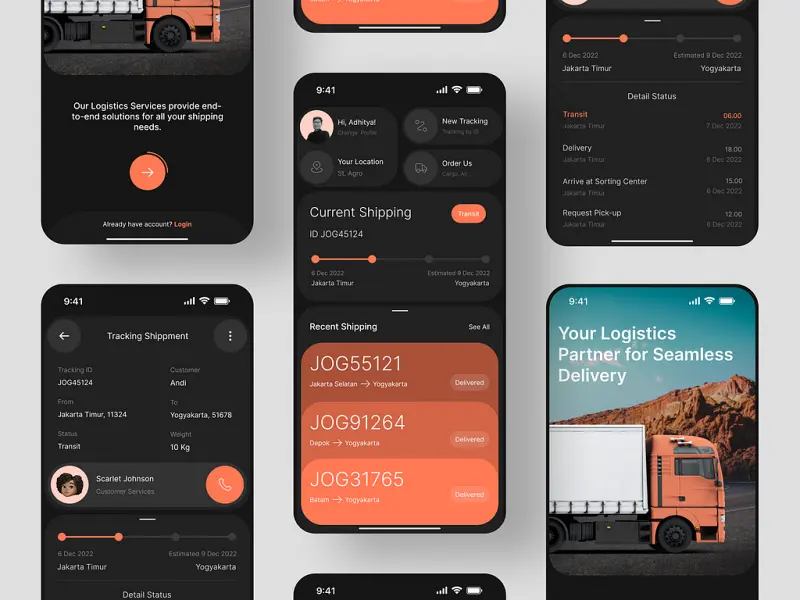
4. Offline Functions
Internet access can sometimes be unreliable. The app remains accessible offline using its mobile version. This allows users to work during network breakdowns and enter data into the app without an internet connection.
5. Chat and Calls to the Driver
Logistics employees can manage issues like vehicle breakdowns or accidents through route adjustments. Additionally, drivers can provide customers with necessary delivery details. Drivers, shippers, and managers can communicate via the app’s calling and messaging features.
6. Cross-Platform App Capabilities
A logistics app should work seamlessly across various operating systems, including iOS, Windows, and Android, without requiring UI changes. It should function well on smartphones and desktops and offer multiple usage methods so users can choose their preferred option.
V. Steps to Create a Logistics Application
This is what you’ve been waiting for, a full logistics app development process:
Step 1: Map Out Your Goals
First, you need to outline the objectives of your logistics software. Your logistics app will possess distinct features and attributes based on your business type and unique requirements. To identify these, you must figure out what you want your app to accomplish.
This process can be complex, but you don’t have to tackle it alone. You can collaborate with an experienced logistics development firm from inception to ensure your app is built quickly and efficiently.
Once you have gathered the necessary information for this step, you can move on to the next phase.
Step 2: Establish a Strong Technological Foundation
The bedrock of a successful logistics app is its technology and infrastructure. Like a house requires a solid foundation to endure various elements, a mobile application needs a robust technology stack to manage the complexities of an ever-evolving industry.
Explore and Select the Right Technologies
Investigate various technologies, frameworks, and programming languages when selecting a technology stack for your logistics app. With many options available, conducting thorough research and choosing the technologies that best align with your app’s requirements is crucial.
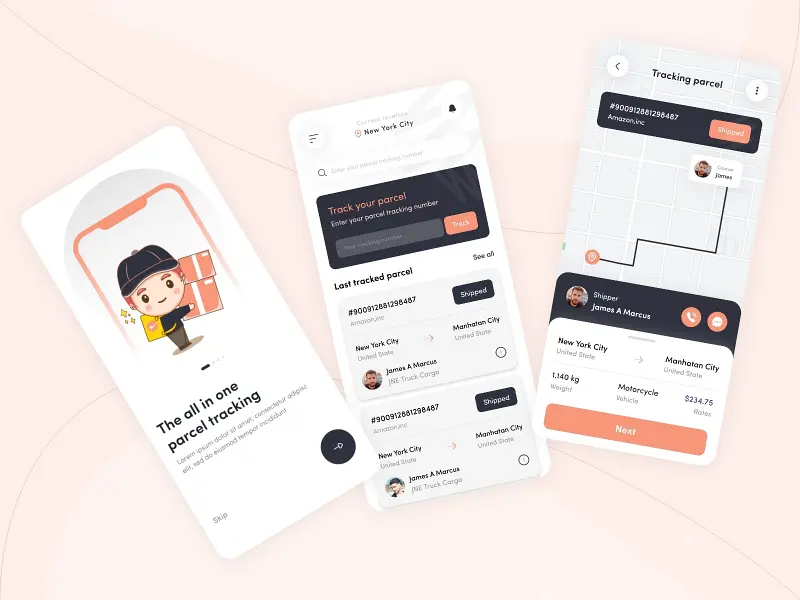
Prioritize Scalability, Security, and Data Privacy
Beyond selecting the appropriate technologies, focusing on your app’s scalability, security, and data privacy is essential. Your logistics app should be capable of supporting your business’s growth and must be fortified against cyber threats. Ensure your app adheres to all relevant data privacy regulations to protect user information.
Build a Sustainable Infrastructure
By meticulously considering your logistics app’s technology and infrastructure needs, you can construct a strong foundation for its success for years.
Design Intuitive Interfaces
In a competitive market, designing user-friendly and intuitive logistics apps is crucial. Users will quickly abandon an app that’s hard to use or navigate.
Step 3: Emphasize User Experience Design
User experience design (UXD) involves designing products with the user in mind. Understanding user requirements and expectations allows UX designers to develop user-friendly and effective applications.
Key Factors in UX Design
Several factors contribute to good UX design in logistics apps:
- Ensure Seamless User Flow: The user flow is the path users take through an app. A straightforward user flow allows users to complete their tasks easily.
- Implement Intuitive Navigation: Navigation is the system users use to move around an app. Effective navigation is clear and helps users find information quickly.
- Create Visually Appealing Interfaces: The user interface (UI) is the visual design of an app. A good UI is attractive and easy to use, with clear fonts, colors, and icons.
- Incorporate Visual Elements: Icons, graphics, and color schemes can enhance usability and make an app more appealing.
- Conduct User Testing and Gather Feedback: User testing involves getting user feedback about the app. This feedback helps identify and fix usability issues.
Step 4: Implement Essential Features and Functionality
A logistics app’s core features and functionality are crucial for its success. Without these essential components, your app will not meet user needs.
Key Features to Include
Some of the most important features for logistics apps include:
- Shipment Tracking: Allows users to track their shipments in real-time. This is crucial for providing peace of mind to customers and ensuring timely delivery.
- Inventory Management: Enables users to monitor the quantity and location of their inventory. This is vital for meeting demand and optimizing storage.
- Order Processing: Lets users process orders quickly and easily. This is important for keeping up with demand and providing a positive customer experience.
- Real-Time Data Updates: Provides users with the latest shipments, inventory, and order data. This is essential for making informed decisions and maintaining smooth operations.
Additional Useful Features
Beyond the core features, consider incorporating the following:
- Push Notifications: Keeps users updated on the status of their shipments, inventory, and orders through timely alerts.
- App Optimization: Ensures your app runs smoothly and efficiently. This involves optimizing code, using the right tools, and thorough testing.
These core and additional features help you meet your users’ needs, allowing you to create a successful and profitable logistics app.
Let’s talk
A consultation with the Client Relationship Manager, who represents TECHVIFY, without any commitment from your side, will give you:
- Structured and clear vision of your future application
- Information about how our software development company guarantees 100% on-time and on-budget delivery
- Recommendations for choosing the tech stack
- Advice on further steps
- Business-side recommendations
- Rough project estimation on software development
TECHVIFY is right where you need. Contact us now for further consultation:
Step 5: Enhance Data Management and Analytics
Data is crucial for any successful business, including logistics apps. Through data collection and analysis, logistics applications can gain insights into user behavior, supply chain optimization, and process improvements. This information helps make better decisions, improve efficiency, and reduce costs.
Techniques for Gathering Data
There are several ways to collect data for logistics apps:
- Utilizing Sensors: Implement sensors to monitor the movement of goods and materials. This data helps track shipment locations, identify supply chain bottlenecks, and optimize delivery routes.
- Collecting User Feedback: Surveys and questionnaires will be used to gather user feedback. This information can improve the user experience, identify areas for improvement, and guide future feature development.
Extracting and Using Insights
Once data is collected, it needs to be analyzed to extract valuable insights. This can be done using various statistical and machine-learning techniques. Logistics apps can better understand their users, supply chains, and processes by analyzing data. This knowledge helps make better decisions, improve efficiency, and reduce costs.
Step 6: Ensuring Quality with Testing and Quality Assurance
Testing and quality assurance (QA) are vital for the success of any logistics app. You can identify and fix bugs or defects before they affect users through thorough testing. This enhances the overall user experience and avoids expensive downtimes.
Types of Testing for Logistics Apps
Various types of testing should be conducted on logistics apps, including:
- Functional Testing: Ensures the app meets its requirements and performs as expected.
- Performance Testing: Verifies that the app can handle the expected load and performs well under stress.
- Usability Testing: Confirms that the app is user-friendly and easy to navigate.
- Security Testing: Verifies that the app is secure and safeguards user information.
Incorporate User Feedback
In addition to these specific testing types, gathering user feedback during the development process is essential. This feedback can highlight areas for improvement and ensure the app meets user needs.
Achieving High-Quality Standards
Implementing these best practices can guarantee that your logistics app is top-notch and meets user requirements.
Step 7: Effective Deployment and Maintenance
Deployment and maintenance are crucial for the long-term success of any logistics app. By following best practices, you can ensure your app remains available, up-to-date, and user-friendly.
Deployment Process
After your app has been developed and tested, the next step is deployment to the chosen platforms. This process will differ based on the platform but typically involves uploading the app to the app store or website.
Maintenance Strategies
After deployment, it’s essential to keep the app updated and well-maintained. This includes monitoring performance, gathering user feedback, and promptly addressing issues. Consistent updates with new features and enhancements are also crucial. Here are some tips for effective deployment and maintenance:
- Select Appropriate Platforms: Choose platforms depending on your target audience and the features you plan to provide.
- Thorough Testing: Test your app extensively on all platforms before deployment to identify bugs or issues.
- Performance Monitoring: Continuously monitor the app’s performance to identify and resolve performance issues.
- User Feedback Collection: Solicit user feedback to improve the application and ensure it fulfills user requirements.
- Prompt Issue Resolution: Address any reported issues quickly to maintain user satisfaction and prevent negative reviews.
- Regular Updates: Keep the app engaging by regularly updating it with new features and improvements.
VI. Factors before doing logistics app development
Understand Your Audience
Identify your target audience’s needs, preferences, and pain points. Customize your app’s features and user experience to cater to their B2B logistics or B2C last-mile delivery requirements.
Design for Scalability
Prepare for future growth by designing your logistics application to manage higher user traffic and data volumes. Scalability is essential to support expanding operations without sacrificing performance.
Integrate with External Systems
Think about integrating your logistics application with external systems such as ERPs, CRMs, or transportation management systems (TMS). This integration improves data flow and overall efficiency.
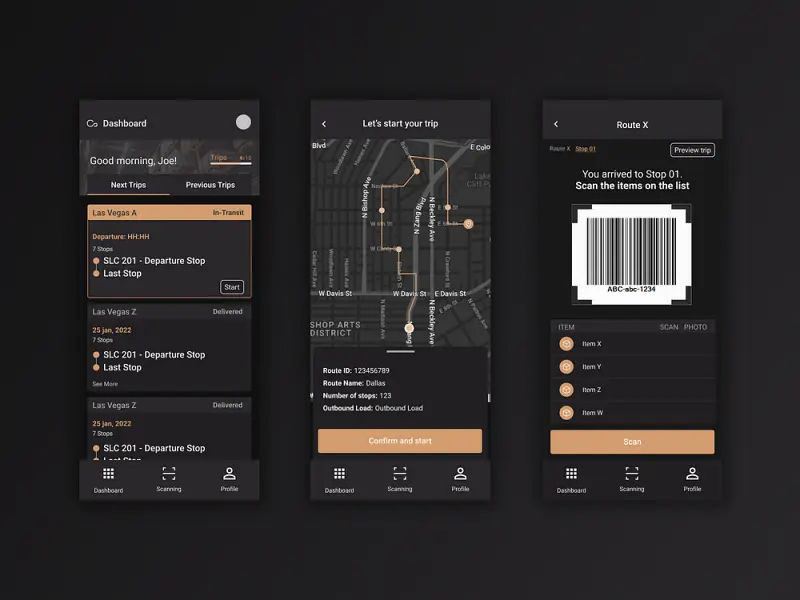
Implement GPS and Geolocation
Incorporate GPS and geolocation services to track shipments, optimize routes, and provide precise delivery estimates. Real-time location updates enhance visibility and customer satisfaction.
Prioritize Security and Data Privacy
Safeguard sensitive data, including customer information, financial details, and supply chain data. Adopt robust security measures to avert data breaches and unauthorized access.
Provide Offline Functionality
Ensure your app can be used offline, especially in areas with poor internet connectivity. This feature allows drivers to access important information and update data without interruption.
VII. Breakdown of the Cost of Logistics App Development
Due to logistics apps’ multifunctional and multifaceted nature, estimating the development cost is challenging. Nonetheless, you can approximate the cost by evaluating the following key factors:
Complexity and Features
The cost of developing a logistics app varies significantly based on its type and complexity. Here’s a breakdown:
- Basic Logistics App: An app with minimal functionality will cost approximately $25,000 to $100,000.
- Moderately Complex App: An app with average complexity and features will cost around $100,000 to $180,000.
- Advanced Logistics App: A fully-fledged app with advanced functionalities and interactive features will cost $180,000.
Frontend and Backend Development
The choice of frontend and backend frameworks and the technology stack significantly impact the overall cost of logistics app development. Consider the following:
- Architecture Choice: Opting for microservices rather than a monolithic architecture can increase costs but offer better scalability.
- Technology Stack: Costs can vary based on the chosen programming languages, databases, and other technologies.
- Scalability Needs: The need to scale your app to accommodate business growth will also influence the cost.
Considering these factors can help you get a more accurate estimate of the cost of developing a logistics app tailored to your business needs.
Conclusion
Logistics app development is a game-changer for businesses looking to streamline operations and boost efficiency.
Whether a small business or a large enterprise, a custom logistics application is your ticket to transformation. The right app guarantees seamless operations and delighted customers.
Ready to revolutionize your logistics operations with a top-tier logistics app development company? At TECHVIFY, we deliver unparalleled consultation and development services tailored to your needs. Our expert team crafts powerful, scalable, user-friendly logistics solutions that drive real impact.
Contact Techvify today for the ultimate consultation and development experience.
TECHVIFY – Global AI & Software Solution Company
From Startups to Industry Leaders: TECHVIFY prioritizes results, not just deliverables. Accelerate your time to market and see ROI early with high-performing teams, AI (including GenAI) Software Solutions, and ODC (Offshore Development Center) services.
- Email: [email protected]
- Phone: (+84)24.77762.666





